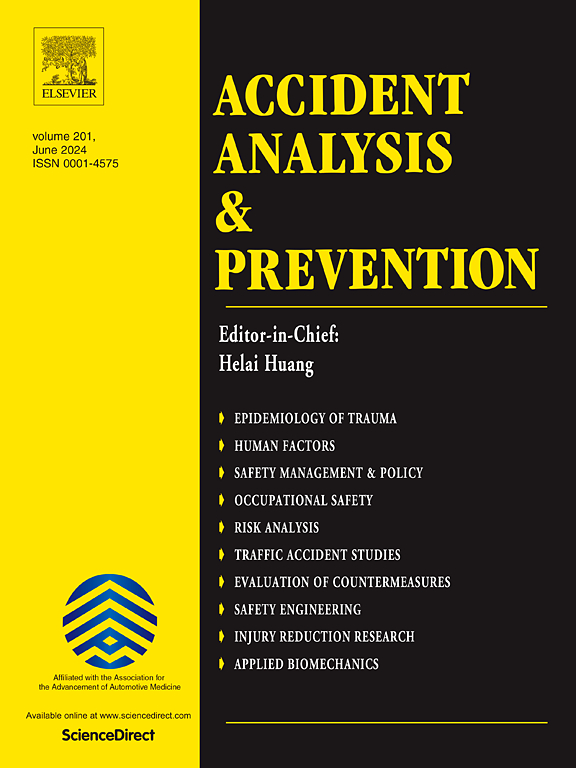Clustering of freeway cut-in scenarios for automated vehicle development considering data dimensionality and imbalance
IF 6.2
1区 工程技术
Q1 ERGONOMICS
引用次数: 0
Abstract
Representative driving scenarios derived by clustering of naturalistic driving data are guidelines for the function definition and algorithm development of automated vehicle. However, current clustering methods struggle with data dimensionality and imbalance, leading to significant biases. To tackle these issues, this study proposed a novel two-layer self-adaptive multiprototype-based competitive learning algorithm, and implemented it in clustering of freeway cut-in scenarios. Firstly, the extracted cut-in segments from naturalistic driving data included environmental, static, and dynamic vehicle elements, composed of discrete, continuous, and time series variables, posing a challenge in multi-dimensional parameter clustering. To tackle this, we utilized the K-medoids clustering method, based on dynamic time warping distance, to cluster variables such as cut-in vehicle velocity, converting them into discrete variables and applying one-hot encoding for easier clustering distance calculations. Secondly, to address the imbalance issue where minority sample categories were absorbed into majority types in naturalistic driving data clustering, we employed a multi-prototype clustering method in the second layer. Each cluster was represented by one or more sub-clusters to ensure adequate representation of minority clusters. Moreover, the inclusion of adaptive competitive learning allowed the algorithm to autonomously determine the optimal number of clusters, eliminating the need for manual parameter tuning. Consequently, the proposed algorithm produced eleven representative freeway cut-in scenarios from 2415 segments, with a better clustering goodness than the other traditional clustering methods. Moreover, four representative cut-in scenarios were frequently appeared in the dataset and commonly recognized by previous studies, whilst seven were rare in the dataset but common in real-world driving circumstances, such as at night, adverse weather conditions, and commercial vehicle cut-in scenarios. These findings suggest that the proposed clustering method effectively addresses the challenges of dimensionality and imbalance, indicating its potential for wide application in constructing representative scenarios for automated vehicles development.
考虑数据维数和不平衡的自动驾驶车辆高速公路切入场景聚类
通过对自然驾驶数据的聚类,推导出具有代表性的驾驶场景,为自动驾驶汽车的功能定义和算法开发提供指导。然而,目前的聚类方法与数据维度和不平衡作斗争,导致显著的偏差。为了解决这些问题,本文提出了一种新的基于两层自适应多原型的竞争学习算法,并将其应用于高速公路切入场景的聚类中。首先,从自然驾驶数据中提取的切入段包含环境、静态和动态车辆要素,这些要素由离散变量、连续变量和时间序列变量组成,给多维参数聚类带来了挑战。为了解决这个问题,我们利用基于动态时间扭曲距离的K-medoids聚类方法来聚类变量,如切入车辆速度,将它们转换为离散变量,并应用one-hot编码,以便更容易地计算聚类距离。其次,针对自然驱动数据聚类中少数样本类别被多数样本类别吸收的不平衡问题,我们在第二层采用了多原型聚类方法。每一组由一个或多个子组代表,以确保少数民族组有充分的代表性。此外,自适应竞争学习使算法能够自主确定最优簇数,从而消除了手动参数调整的需要。结果表明,该算法从2415个路段中产生了11个具有代表性的高速公路切入场景,聚类效果优于其他传统聚类方法。此外,有四种代表性的切入场景经常出现在数据集中,并且通常被先前的研究所识别,而七种场景在数据集中很少出现,但在现实驾驶环境中很常见,例如夜间、恶劣天气条件和商用车切入场景。这些结果表明,本文提出的聚类方法有效地解决了维度和不平衡的挑战,表明其在构建自动驾驶汽车开发的代表性场景方面具有广泛的应用潜力。
本文章由计算机程序翻译,如有差异,请以英文原文为准。
求助全文
约1分钟内获得全文
求助全文
来源期刊

Accident; analysis and prevention
Multiple-
CiteScore
11.90
自引率
16.90%
发文量
264
审稿时长
48 days
期刊介绍:
Accident Analysis & Prevention provides wide coverage of the general areas relating to accidental injury and damage, including the pre-injury and immediate post-injury phases. Published papers deal with medical, legal, economic, educational, behavioral, theoretical or empirical aspects of transportation accidents, as well as with accidents at other sites. Selected topics within the scope of the Journal may include: studies of human, environmental and vehicular factors influencing the occurrence, type and severity of accidents and injury; the design, implementation and evaluation of countermeasures; biomechanics of impact and human tolerance limits to injury; modelling and statistical analysis of accident data; policy, planning and decision-making in safety.
 求助内容:
求助内容: 应助结果提醒方式:
应助结果提醒方式:


